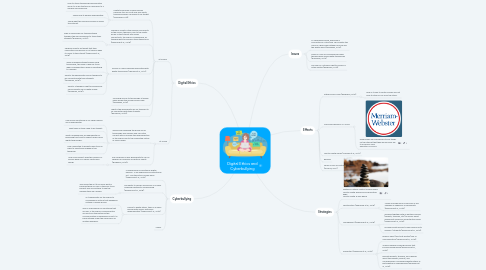
1. Cyberbullying
1.1. "Cyberbullying is inflicted by digital devices... is an aggressive and intentional act... and the action causes harm" (Redmond et al., 2018)
1.2. The ability to remain anonymous is a major challenge relating to cyberbullying (Redmond et al., 2018).
1.2.1. This drives the act to be more hurtful because there is a loss of the bully to be present and accountable to see the damage they are causing.
1.3. Similar to digital ethics, there is a major overlap with school and home responsibilities (Redmond et al., 2018)
1.3.1. Is it appropriate for the school to consequence actions that happened outside of school hours?
1.3.2. Who is responsible for monitoring that access? If the school is providing the accounts for the platforms this communication is happening on but it is being utilized under the supervision of another guardian?
1.4. Types:
2. Digital Ethics
2.1. At School
2.1.1. Digital technology is becoming an everyday tool for most kids and adults, therefore proper use needs to be taught (Buchanan 2019).
2.1.1.1. How to utilize technology appropriately since it is a skill that will be necessary to a modern day workforce.
2.1.1.2. Teach how to behave appropriately.
2.1.1.3. Teach what the risks are involved in using the internet.
2.1.2. Children's Safety is the number one priority of the school, therefore, due to the safety issues of the internet and media connectivity, the school is responsible for teaching how to properly utilize these tools (Redmond et al., 2018).
2.1.2.1. Who is responsible for teaching these teachers the skills necessary to teach their students (Buchanan, 2019)?
2.1.3. Privacy is a new challenge associated with digital technology (Thomas et al., 2014).
2.1.3.1. Children need to be taught that their information and privacy is not secure when it comes to the internet (Redmond et al., 2018).
2.1.3.2. When managing students while using technology, the issue of how far to go when managing their usage is something to consider.
2.1.3.3. What is the appropriate use for teachers to be connected with their students (Buchanan, 2019)?
2.1.3.4. What is a teacher's right to professional versus private use of digital media (Buchanan, 2019)?
2.1.4. Providing access to technology at school helps bridge the socioeconomic gap (Buchanan, 2019)
2.1.5. What is the appropriate use for teachers to be connected with their students (Buchanan, 2019)?
2.2. At Home
2.2.1. Issues arise regarding the home use of technology and children and can often conflict with or overlap the responsibilities of the school due to the connected nature of social media
2.2.1.1. How much monitoring of my child's device use is appropriate?
2.2.1.2. What skills actually need to be taught?
2.2.1.3. What consequences are appropriate for breaching trust and/or respect when using digital technology?
2.2.1.4. How connected to parents need to be in order to effectively engage in this teaching?
2.2.2. Are surveillance uses appropriate to use on children for purposes of heath or safety (Buchanan, 2019)?
2.2.2.1. How much impact does the invasion of privacy have on a child's mental well being?
3. Issues
3.1. In a globalized world, everyone is connected all of the time. This creates the issue of a grey area between real life and the digital world (Buchanan, 2019).
3.2. There is a lack of consequence based thinking when using digital technology (Buchanan, 2019)
3.3. The line for a citizen's right to privacy is often shifted (Buchanan, 2019)
4. Strategies
4.1. Waterloo Catholic District School Board Mental Health Resource and Education page Mental Health & Well-Being
4.2. Identification (Redmond et al., 2018)
4.2.1. Loved ones should be conscious of any changes of behaviour or personality (Redmond et al., 2018).
4.3. Management (Redmond et al., 2018)
4.3.1. Working together with all parties involved (parents, teachers, etc) to inform about adolescent dynamics and potential issues (Redmond et al., 2018).
4.3.2. Provide private access to help resources to children / students (Redmond et al., 2018).
4.4. Prevention (Redmond et al., 2018)
4.4.1. Keep an open (and trust worthy) line of communication (Redmond et al,. 2018).
4.4.2. Schools develop bullying policies that include cyberbullying (Redmond et al., 2018).
4.4.3. Educate parents, teachers, and children about the dangers, effects, and consequences of breaching digital ethics or participating in cyberbullying (Redmond et al., 2018).
5. Effects
5.1. Altered moral code (Buchanan, 2019).
5.1.1. Why is it okay to pirate movies and not okay to steal a DVD from the store?
5.2. "Key board warriors" or "Trolls"
5.2.1. People who are emboldened to say things on the internet that they would never say to a persons face Definition of TROLL

